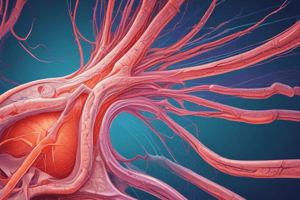Podcast
Questions and Answers
Which type of connective tissue provides the primary structure for bones?
Which type of connective tissue provides the primary structure for bones?
Which cell type in connective tissue is responsible for producing fibers?
Which cell type in connective tissue is responsible for producing fibers?
What is the primary function of macrophages within connective tissue?
What is the primary function of macrophages within connective tissue?
Which type of connective tissue fiber is primarily responsible for resisting stretching?
Which type of connective tissue fiber is primarily responsible for resisting stretching?
Signup and view all the answers
Which type of connective tissue is primarily involved in binding structures together?
Which type of connective tissue is primarily involved in binding structures together?
Signup and view all the answers
Which of the following connective tissue types is classified as being liquid?
Which of the following connective tissue types is classified as being liquid?
Signup and view all the answers
What is a key characteristic of elastic connective tissue fibers?
What is a key characteristic of elastic connective tissue fibers?
Signup and view all the answers
The primary structural support in tendons and ligaments is provided by which type of connective tissue fiber?
The primary structural support in tendons and ligaments is provided by which type of connective tissue fiber?
Signup and view all the answers
Which connective tissue fiber is characterized by being thin and coated with glycoprotein?
Which connective tissue fiber is characterized by being thin and coated with glycoprotein?
Signup and view all the answers
What distinguishes elastic fibers from collagen fibers?
What distinguishes elastic fibers from collagen fibers?
Signup and view all the answers
Study Notes
Characteristics of Connective Tissue
- Connective tissue is well vascularized except in cartilage, tendons, and ligaments.
- Connective tissue has loosely connected cells.
- Connective tissue cells are suspended in a matrix.
- Connective tissue contains three general cell types: fibroblasts, macrophages, and mast cells.
- Fibroblasts produce fibers.
- Macrophages are white blood cells that are part of the immune system.
- Mast cells produce heparin, an anti-clotting agent, and histamine.
Functions of Connective Tissue
- Connective tissue provides protection in various ways:
- Bones protect vital organs.
- Cartilage cushions and protects joints.
- Adipose tissue (fat) insulates and protects organs.
- Connective tissue binds structures together:
- Tendons connect muscles to bones.
- Ligaments connect bones to bones.
- Connective tissue provides support:
- Bones provide structural support for the body.
- Cartilage provides support for the nose, ears, and trachea.
- Connective tissue transports substances:
- Blood transports oxygen and nutrients to cells and removes waste products.
Types of Connective Tissue
-
Bone is a hard, rigid connective tissue.
- Compact bone is dense and tightly packed.
- Spongy bone is porous and lightweight.
-
Cartilage is a flexible, supportive connective tissue that cushions joints.
- Hyaline cartilage, the most common type, is found in the nose, trachea, and joints.
- Elastic cartilage is more flexible and found in the ears and epiglottis.
-
Dense connective tissue is strong and contains a high density of fibers.
- Dense regular connective tissue is found in tendons and ligaments, where fibers are arranged in a parallel fashion.
- Dense irregular connective tissue has fibers arranged randomly and is found in the dermis of the skin.
- Elastic connective tissue has a high concentration of elastic fibers and is found in the walls of arteries and some ligaments.
-
Loose connective tissue is less dense and more flexible than dense connective tissue.
- Areolar connective tissue is found throughout the body and contains a variety of cells and fibers.
- Adipose tissue stores fat and is found beneath the skin and around organs.
- Reticular connective tissue forms the framework of organs such as the spleen, lymph nodes, and bone marrow.
-
Liquid connective tissue is a fluid and contains cells suspended in a matrix.
- Blood transports oxygen, nutrients, and waste products.
- Lymph filters waste and bacteria.
Density Decreases as You Move from Bone to Liquid Connective Tissue
- Bone is the densest connective tissue.
- Cartilage is less dense than bone.
- Loose connective tissue is less dense than cartilage.
- Liquid connective tissue is the least dense.
Fibres of Connective Tissue
- Collagen fibers are tough, flexible fibers that resist stretching. They are found in tendons, ligaments, and bones.
- Reticular fibers are thin collagen fibers coated with glycoprotein. They form delicate networks within tissues, such as in the spleen, liver, and lymph nodes.
- Elastic fibers are thinner than collagen fibers and are made up of the protein elastin. They can stretch and recoil, allowing tissues to return to their original shape. Elastic fibers are found in the walls of arteries, lungs, and skin.
Studying That Suits You
Use AI to generate personalized quizzes and flashcards to suit your learning preferences.
Description
This quiz explores the essential characteristics and functions of connective tissue. It covers the types of cells involved, their roles, and how connective tissue provides protection, binding, and support in the body. Test your knowledge on this fundamental aspect of human anatomy.




